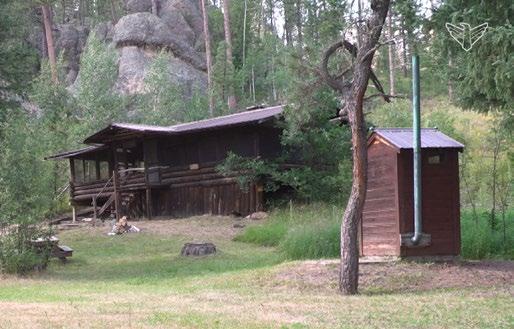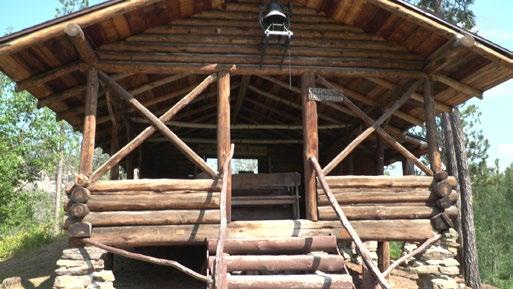
6 minute read
BLACK HILLS HIDEAWAYS: PRIVATE CABINS ON PUBLIC LAND BY SETH TUPPER
Scattered around the Black Hills, tucked away in the forests and meadows, there’s a curiosity: privately owned vacation cabins on public land.
One of the oldest is the Durst cabin. A logging family built the cabin in a meadow along Flynn Creek around 1911.
Eight years later, Custer State Park was born. Its boundaries soon wrapped around the vintage cabin, with its dark wood walls, screened-in porch and outhouse. Today, the cabin still stands within the park.
And the cabin still belongs to Durst descendants. They own the building and use it as a private gathering place, even though they don’t own the land.
Lloyd Marsden, of Sheridan, Wyoming, is a greatgrandson of the original owners. He said seven generations have ties to the place.
“Ashes of several of those people have been spread here,” Marsden said. “So it goes a long way back, and there’s a chance to connect with those earlier generations.”
The Durst family isn’t the only one with a private connection to public land in the Black Hills.
Beginning in the 1910s and ’20s, hundreds of people were allowed to build cabins within the boundaries of Custer State Park and the Black Hills National Forest.
The goal of the programs, as explained by Matthew Jurak, a recreation and lands staff officer for the Black Hills National Forest, was to attract visitors and build support for public lands.
“I think that was really the intent all along, to have a personal connection with the natural environment and the forest itself,” Jurak said. “So, for a Forest Service employee looking back to the early 1900s, I think that was pretty progressive. They were looking ahead.”
When the programs ended in the 1960s, existing cabins were allowed to stay. Nearly 200 remain – about 35 in Custer State Park, and almost 160 across the million-acre Black Hills National Forest.
Neither the park nor the forest plans to allow any new cabins on public land, so the owners of the old cabins are an exclusive club. They pay annual leases ranging from about $400 to $2,000. They can’t live in the cabins full-time, they’re not allowed to rent the cabins out, and they have to get approval for repairs and renovations.
Some cabins are far off the beaten path, at the end of rutted two-track trails. Many are small and rustic, with plain brown exteriors. Some lack plumbing, running water and cell-phone service. Others have been updated with a few modern amenities.
Continued on the next page. Cabins are passed between generations

Black Hills Cabins continued.
Families pass the cabins down through generations, but occasionally they come up for sale. The lease transfers have to be approved by publiclands managers.
‘Best decision that we ever made’
Brad and Connie McKinney, of Custer, were living in Nebraska 30 years ago when Brad saw a classified ad for a cabin in the Black Hills.
He said Connie needed convincing.
“I think there was some trepidation on Connie’s part – with two kids in diapers and no running water and an outhouse and such – that maybe it wasn’t the smartest thing to do,” Brad said. “But I was maybe the pusher of that decision, and I think she came to appreciate it.”
Connie now calls the purchase “the best decision that we ever made.”
“Oh, I thank him all the time,” she said. “Literally, I say, ‘I am so glad you didn’t let me moan and groan.’”
The McKinneys calls their cabin visits “French Creek time.” They’ve hiked and explored the park,

fished and waded in the creek, and snowshoed the area in the winter. One of their kids got married at the cabin.
Future uncertain for state park cabins
The King family of Chadron, Nebraska, has similar stories. Their Custer State Park cabin dates to the 1930s, when it served as an office for the Civilian Conservation Corps. The cabin has been in Don’s family since the ’50s.
The cabin still bears the look of the CCC, with forest-green interior walls, a stout stone fireplace and a hand-hewn table and chairs.
“What is not to like about being here?” Stephanie said. “It is peaceful. It’s just somewhere that, I don’t know, it just is good to your soul.”
But the future is uncertain for the private cabin owners of Custer State Park.
Through the terms of a long-ago agreement, leases with the park all expire in nine years. In 2029, the Kings, the McKinneys, the Durst descendants and all the other cabin owners in the park face the prospect of eviction, and the additional problem of figuring out whether and how to move their cabin.
Don and Stephanie King have mixed emotions about it.
“We’ve been here for 19 years and we have another nine years left with our family,” Don said. “That’s a long time, and so it’s been well worth it. We don’t begrudge it at all.”
Stephanie nodded in agreement but then interjected with a laugh, “Yeah, well, I don’t know if I agree, but anyway …”
No plan to terminate Forest Service leases
Cabins on Black Hills National Forest land
appear to have a longer future. They were built as part of a nationwide Forest Service program. There are 14,000 private cabins in national forests around the country, and the owners have a national association.
The Forest Service leases run for 20 years and include many of the same provisions as the state leases. People own the buildings, not the land, and they need permission to make changes to their cabins.
The leases all expire in 2028, but Forest Service officials say the leases are likely to be renewed, as long as cabin owners adhere to the program requirements.
Mary Smrcka, of Custer, is restoring one of the old national forest cabins. It sits above a creek in an otherwise dead-silent pocket of forest near the Black Elk Wilderness.
“Isn’t this just wonderful?” she said during a recent visit to the cabin. “Who could be as lucky as this? It’s just plain grand.”
Smcrka was working as a hospital lab tech when she bought the cabin.
“And you need a break,” she said. “You need a place that’s so different and so uplifting, really, and the natural surroundings are helpful. It helps you recuperate from that job.”
Now she’s retired and spends hours reading and relaxing at the cabin with her dog.
Continued on the next page.
VIDEO: Private Cabins, Public Land on Dakota LIfe
Black Hills Cabins continued.
For everyone else: Camp Remington
Not everyone can own a wilderness cabin, but there is a way for the rest of us to enjoy a private cabin in a public forest.
The Episcopal Diocese of South Dakota built Camp Remington as a clergy retreat in the 1920s. The three cabins are closed this summer during the pandemic, but otherwise, they’re available to rent for $35 a night.
The cabins are allowed on public land through a Forest Service lease. They have many of the same traits as the privately owned cabins – like no running water and no electricity.
Key Parker is one of the Camp Remington caretakers. He said it’s the perfect place for people who crave solitude.
“It’s just real peaceful sitting out here. And you can relax,” Parker said, “like no place else.”

VIDEO: A Tour of Camp Remington






